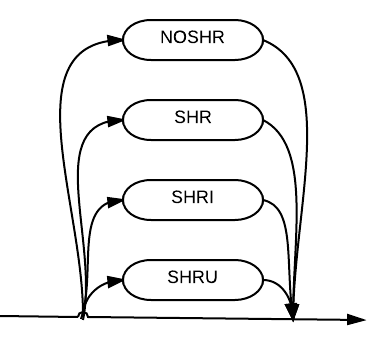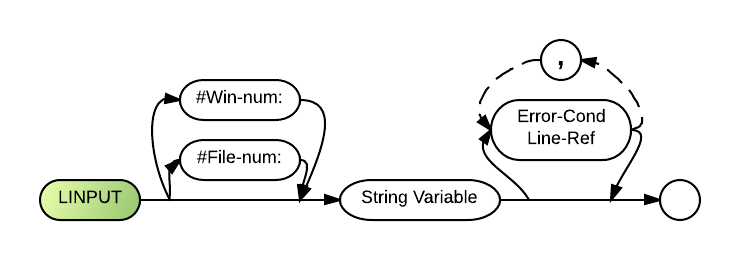Diagram Conventions
Diagram Rules
- Syntax diagrams show the optional and required parameters for statements, commands and specifications. The following LINPUT statement diagram will serve as an example for the set of rules, which applies to all Business Rules syntax diagrams
- Read from left to right
The logic and order of the syntax always flows from left to right.
- Uppercase parameters are exact keywords
Items in uppercase letters (LINPUT) are keywords and must be typed in either exactly as they appear or with an allowable abbreviation (see keyword abbreviations for a complete list).
- Lowercase parameters must be replaced
Items in lowercase letters (string-var) are specifically defined in the Parameters section following each syntax diagram. When specified, these parameters must be replaced with a specification that fits the requirements of the definition. Descriptions of these parameters can be found in the Definitions or All Parameters sections.
- Include special characters
Special characters, such as commas, colons and slashes (the colon in filenum:) must be included in the written statement.
- Items on the main line are required
Items that appear on the main line of the diagram (string-var) must be included in the written statement. If you can follow the line of the diagram to the end without passing a parameter, it is optional.
- Items with a returning dotted line may be repeated.
When multiple items are used, they must be separated with the punctuation mark (usually a comma or semi-colon).
- Defaults are listed in angle brackets
Numbers that are enclosed in brackets (<1>) identify the default action or value, which is taken when nothing is specified for an optional parameter. These numbers correlate to the "Defaults" section below each diagram.
- Insertable diagrams
Some of Business Rules commands and statements are so powerful that it is difficult to show all the available options in a single diagram. In such cases, a section of the diagram is shown separately as an "insertable syntax". An example of this usage is the "helpstring" parameter that appears in several diagrams, including INPUT FIELDS. Another example is the "share spec" parameter (shown below). Insertable diagrams do not have start and end circles to prevent them from being confused with full syntax diagrams.

- End of statement
The circle at the end of the diagram identifies the end of the statement.
For more details, see the Syntax description.
